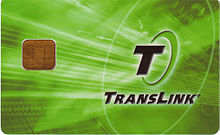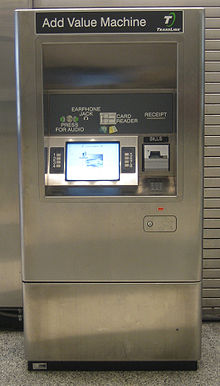- Clipper card
-
Clipper 
Location San Francisco Bay Area Launched 2010 Operator Cubic Transportation Systems Manager Metropolitan Transportation Commission Currency United States dollar (USD) ($300 maximum load) Validity AC Transit Bay Area Rapid Transit (BART) Caltrain Golden Gate Transit Muni SamTrans VTA Website Clippercard.com The Clipper card is a reloadable contactless smart card used for electronic transit fare payment in the San Francisco Bay Area. First introduced as Translink in 2002 by the Metropolitan Transportation Commission (MTC) as a pilot program, Clipper was rebranded into its current form and launched in 2010. Clipper is being rolled out gradually; as of July 2011, seven transit agencies accept the card.
In October 2010, the MTC selected 路路通 (Pinyin: Lùlùtōng)[1][2] as the official Chinese name for the Clipper Card.
Contents
History
In 1993, Bay Area Rapid Transit (BART) and County Connection launched a pilot program named Translink (not to be confused with the later incarnation) that allowed the use of a single fare card between the two systems.[3] Using magnetic stripe technology, the card was envisioned to eventually include all Bay Area transit agencies under its umbrella. However, due to technical problems, the program was abandoned two years later.[3]
The project as initially undertaken in 1993 had a projected capital cost of $4 million;[3] in its current conception was expected to cost $30 million.[4] Since then, costs have increased—current forecasted 25-year capital and operations costs are estimated at $338 million.[4] In addition, schedule delays have added up to more than a decade. In 1998, TransLink (now Clipper) was to be available on all transit agencies by 2001.[5] However, in 2009, it was fully operational on five, and not expected to be available regionwide until 2010 or later.[6]
The Clipper card was developed by Australian-based ERG Group and Motorola under the ERG-Motorola alliance in April 1999, and is considered to be the largest smart-card project in the United States. However, upon the launch of Clipper, Cubic Transportation Systems has taken over administration of distribution, customer service, and financial settlement of the program.[7]
In general, the rollout of Clipper has been much slower than that of similar contactless smart cards cards including Oyster card and SmarTrip, chiefly due to bureaucratic difficulties.[8]
Usage
Clipper is fully functional for seven transit agencies:[9]
- AC Transit, including Dumbarton Express
- Bay Area Rapid Transit (BART)
- Caltrain
- Golden Gate Bridge, Highway and Transportation District (Golden Gate Transit and Golden Gate Ferry)
- SamTrans
- San Francisco Municipal Railway (Muni), except cable cars
- Santa Clara Valley Transportation Authority (VTA)
Clipper cards can be used on Muni's cable cars only if a valid monthly pass is loaded; otherwise, cash fare must be used.[10]
Several important transit agencies serving the area that have not joined the system include Altamont Commuter Express (ACE), Amtrak, County Connection, Tri-Delta Transit, WestCAT, and WHEELS.
On June 16, 2010, TransLink changed its name to Clipper, and has since rolled out logo changes to cards and card readers everywhere they previously existed.[11][12][13] Upon the launch of Clipper, the maximum amount of e-cash permitted is $250, up from the original $100 under the TransLink branding when adding value over its website, but the maximum amount on any Clipper card is still confined to $300.[14]
Statistics
Approximately 182,000 cards have been distributed throughout the region as of August 2009. The average number of weekday transactions in that month was 31,850. AC Transit riders accounted for about 44% of the riders using Clipper, Golden Gate Transit and Ferry accounted for 31%, Muni riders 21%, and BART and Caltrain together under 4% (both systems began accepting TransLink in August 2009).
Each transit agency has conducted surveys of its customers to determine customer satisfaction. Below are some highlights of the findings:
- AC Transit: 89.9% of customers surveyed would recommend Clipper to a friend. (May 2008)
- Golden Gate Transit: 85.5% of customers surveyed are satisfied or very satisfied. (October 2008)
- Muni: 82.9% of customers surveyed are satisfied or very satisfied, and 92.1% would recommend Clipper to a friend. (Summer 2009)
Results for BART and Caltrain are not yet available.
Adding funds
The Clipper Card can be remotely loaded with funds either online or by telephone. Remote loading does not occur instantaneously; instead it takes 3-5 business days to transfer funds from a bank account or credit card to the Clipper Card. The Clipper Card site says that this delay is due to the need for the pass or cash value to be batched up and distributed to the various card readers, allowing the credit to be applied to the card the next time you use it. However, adding both e-cash and various transit agency passes to a card can be done at ticket machines present in all BART and Muni stations, as well as other retail outlets.[15] These purchases take effect immediately.[16] Automatic loading of e-cash and some passes ("autoload") can be pre-authorized. When the card balance falls below $10 or a pass expires, additional funds are automatically transferred with no delay.
See also
References
- ^ "ClipperSM Card Grows in Popularity and Reaches Out to Chinese Market". Metropolitan Transportation Commission. http://www.mtc.ca.gov/news/current_topics/10-10/clipper_chinese.htm. Retrieved July 9, 2011.
- ^ 李秀蘭 (October 8, 2010). "公車儲值卡 中文名路路通" (in Chinese). World Journal. http://sf.worldjournal.com/view/full_sfnews/9835564/article-公車儲值卡-中文名路路通. Retrieved July 9, 2011.
- ^ a b c Fimrite, Peter (November 15, 1995). "Coding Problems To Derail BART's Translink Program". San Francisco Chronicle. http://www.sfgate.com/cgi-bin/article.cgi?f=/c/a/1995/11/15/MN18521.DTL. Retrieved July 9, 2011.
- ^ a b Metropolitan Transportation Commission Fund Management System. Metropolitan Transportation Commission. http://www.mtc.ca.gov/funding/fms_intro.htm. Retrieved 2008-06-19
- ^ Bowman, Catherine (1998-01-15). "Multitransit Card Proposed". San Francisco Chronicle. http://www.sfgate.com/cgi-bin/article.cgi?f=/c/a/1998/01/15/MN71750.DTL&hw=translink&sn=052&sc=271.
- ^ Gordon, Rachael (2007-11-27). "TransLink backers consider letting people pay for parking with card". San Francisco Chronicle. http://www.sfgate.com/cgi-bin/article.cgi?f=/c/a/2007/11/27/BA74TJGGE.DTL&hw=translink&sn=007&sc=605
- ^ "Cubic Supports Metropolitan Transportation Commission in Launching ClipperSM Card for San Francisco Bay Area". http://cts.cubic.com/AboutUs/News/News/tabid/434/articleType/ArticleView/articleId/17/language/en-US/Cubic-Supports-Metropolitan-Transportation-Commission-in-Launching-ClippersupSMsup-Card-for-San-Francisco-Bay-Area.aspx. Retrieved 30 May 2011.
- ^ Mara, Janis (June 11, 2009). "Bay Area universal transit card stalls". Contra Costa Times: p. 1. http://www.contracostatimes.com/traffic/ci_12571572. Retrieved June 22, 2009.
- ^ "Where to use Clipper". Metropolitan Transportation Commission. https://www.clippercard.com/ClipperWeb/useTranslink.do. Retrieved December 25, 2010.
- ^ "Clipper® on Cable Cars for monthly pass holders". http://www.sfmta.com/cms/malerts/TransLinkonCableCarsformonthlypassholders.htm. Retrieved July 9, 2011.
- ^ Cabanatuan, Michael (February 10, 2010). "City Insider : Translink, step aside". The San Francisco Chronicle. http://www.sfgate.com/cgi-bin/blogs/cityinsider/detail?entry_id=56942.
- ^ http://www.sfexaminer.com/opinion/blogs/under-the-dome/Frequently-plagued-Translink-card-could-soon-have-a-new-identity-79688952.html
- ^ http://www.sfexaminer.com/local/Rebranding-TransLink-80384712.html
- ^ https://www.clippercard.com/ClipperWeb/privacy.do
- ^ "Find Retail Locations". Metropolitan Transportation Commission. http://www.clippercard.com/ClipperWeb/map.do. Retrieved Ferbruary 9th, 2011.
- ^ "Timing for adding value". Metropolitan Transportation Commission. https://www.clippercard.com/ClipperWeb/useWaysToAddValue.do#timing. Retrieved Ferbruary 9th, 2011.
External links
Categories:- Contactless smart cards
- Fare collection systems in the United States
- Public transportation in San Francisco, California
- Public transportation in San Mateo County, California
- Public transportation in Santa Clara County, California
- Public transportation in Alameda County, California
- Public transportation in Contra Costa County, California
- Public transportation in Marin County, California
- Public transportation in Sonoma County, California
- Transportation in Oakland, California
Wikimedia Foundation. 2010.


